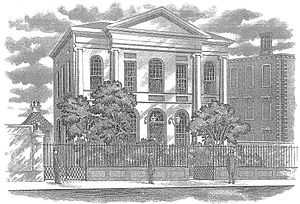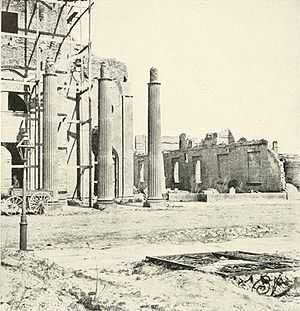St. Andrew's Hall


This picture posted is the remains of the Circular Congregational Church, but it is not of St Andrew's Hall. Institute Hall was located next to the Circular Congregational Church on Meeting Street. St. Andrew's Hall was located on Broad Street, next to St John and St Finnbar Catholic Church. So essentially the picture is wrong and should not be in a posting about St Andrew's Hall.
St. Andrew's Hall was a public building in Charleston, South Carolina, on Broad Street. The hall served as headquarters for the St. Andrew's Society of Charleston, South Carolina. It was also an important part of the social life of upper-class Charlestonians. It was used for balls, banquets, concerts, and meetings of organizations like the South Carolina Jockey Club and the St. Cecilia Society. The hall could also be used for lodging, and both President James Monroe and General Marquis de Lafayette stayed there.
On December 19, 1860, delegates from South Carolina met at St. Andrew's Hall to discuss possible secession from the United States. The following day, they met in Institute Hall on Meeting Street, which became known as Secession Hall and voted 169 to 0 to secede. South Carolina delegates later ratified the Confederate Constitution there on April 3, 1861. South Carolina was the first state to secede from the Union.
The St. Andrew's Hall as well as Secession Hall were both destroyed during a Charleston fire on December 11, 1861[1]
References
- Calore, Paul. (2002). Naval Campaigns of the Civil War. Jefferson, North Carolina: McFarland & Company, Inc., Publishers.
- Edgar, Walter (1998). South Carolina: A History. Columbia: University of South Carolina Press.
- McInnis, Maurie D. (2005). Politics of Taste in Antebellum Charleston. University of North Carolina Press.
- Moise, Warren (2003). Rebellion in the Temple of Justice: The Federal and State Courts in South Carolina During the War Between the States. Lincoln, Nebraska: iUniverse, Inc.
- Sketch of The St. Andrew's Hall is from the South Carolina Historical Society in Charleston on Chalmers Street
- ↑ "An Historic Hall". Retrieved 15 September 2013.